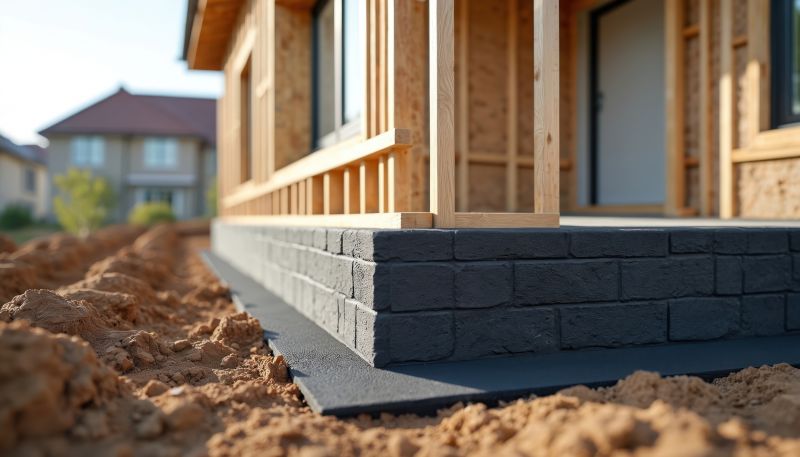Favorite Basement Waterproofing Tools and Products for Homeowners
Get insights into the most popular waterproofing products that help homeowners maintain a dry and healthy basement.
 Basement waterproofing products are essential tools for maintaining a dry and structurally sound space beneath a building. These products help prevent water intrusion from external sources such as rain, groundwater, or plumbing leaks, which can lead to mold growth, structural damage, and compromised indoor air quality. Proper waterproofing involves a combination of materials and techniques tailored to the specific needs of each basement environment.
Basement waterproofing products are essential tools for maintaining a dry and structurally sound space beneath a building. These products help prevent water intrusion from external sources such as rain, groundwater, or plumbing leaks, which can lead to mold growth, structural damage, and compromised indoor air quality. Proper waterproofing involves a combination of materials and techniques tailored to the specific needs of each basement environment.
Top Overall Option
Comprehensive Basement Waterproofing System
A complete waterproofing system often includes a combination of high-quality sealants, membranes, drainage panels, and sump pump setups. These integrated solutions provide a layered defense against water intrusion, helping to manage moisture levels effectively. When properly installed and maintained, such systems can be adaptable to various basement conditions, offering a versatile approach to waterproofing.
Types of Products For Basement Waterproofings
Liquid Waterproofing Membranes
Flexible liquid coatings that form a seamless barrier on basement walls and floors, helping to prevent water seepage.
Rubberized Sealants
High-performance sealants used to fill cracks and joints, providing a waterproof seal in vulnerable areas.
Waterproofing Paints
Specialized paints designed to add a protective layer to basement surfaces, reducing water penetration.
Drainage Mats and Panels
Materials installed on walls or floors to channel water away from the foundation and promote drainage.
French Drains
Underground drainage systems that collect and divert water away from the basement perimeter.
Sump Pumps
Mechanical pumps installed in basements to remove accumulated water and prevent flooding.
Waterproofing Membranes
Physical barriers applied to foundation walls to block water entry and protect the structure.
Crack Injection Kits
Products used to seal and stabilize cracks in basement walls, preventing water infiltration through structural breaches.
Foundation Coatings
Protective coatings applied directly to foundation surfaces to enhance water resistance.
Vapor Barriers
Materials installed on floors or walls to prevent moisture vapor transmission into the basement space.
Hydraulic Cement
Fast-setting cement used to patch leaks and cracks in foundation walls and floors.
Waterproofing Collars
Devices fitted around pipes and conduits to seal penetrations and prevent water entry.
Popular Choices
Versatile sealants used to fill cracks and joints, helping to block water entry in various basement areas.
Coatings applied to walls and floors to provide a water-resistant surface barrier.
Installed around the foundation perimeter to direct water away from the basement.
Complete setups for removing water that collects in the basement sump area.
Physical barriers that adhere to foundation walls to prevent water penetration.
Products designed for sealing and stabilizing cracks in basement walls.
Paints formulated to add an extra layer of protection on basement surfaces.
Materials installed on floors or walls to prevent moisture vapor transmission.
Fast-setting cement for sealing leaks and cracks in concrete surfaces.
Installations on walls to facilitate water runoff and prevent buildup.
Sealing devices around pipes and penetrations to prevent leaks.
Flexible sealants used to fill gaps and cracks around pipes and conduits.
Self-adhesive tapes used for quick sealing of cracks and joints.
Protective coatings designed to enhance foundation waterproofing.
Pre-packaged drainage solutions for perimeter water management.
Effective basement waterproofing begins with assessing the source and extent of water intrusion. Once identified, a variety of products can be employed, including sealants, membranes, drainage systems, and sump pumps. Sealants and coatings are often used to create a water-resistant barrier on walls and floors, while drainage systems like French drains channel water away from the foundation. Sump pumps are installed to remove accumulated water that may seep into the basement.
Choosing the right waterproofing products depends on several factors such as the basement's construction type, the severity of water intrusion, and the local climate. Proper installation and maintenance of these products are crucial for ensuring long-term effectiveness. Regular inspections and timely repairs can help prevent minor issues from escalating into major problems, preserving the integrity of the foundation and the usability of the basement space.
Investing in quality basement waterproofing products can provide peace of mind by reducing the risk of water-related damages. While no single product can guarantee complete dryness under all conditions, a combination of appropriate materials and professional guidance can significantly improve the basement's resilience against moisture infiltration. Understanding the different product options and their applications is key to making informed decisions for your basement waterproofing needs.
Key Buying Considerations
- Assess the severity and source of water intrusion before selecting products.
- Choose products compatible with your basement's construction materials.
- Consider the ease of installation and whether professional assistance is needed.
- Evaluate the product’s durability and resistance to environmental factors.
- Look for products with good adhesion properties to prevent peeling or detachment.
- Select solutions that address both surface sealing and drainage needs.
- Ensure compatibility with existing waterproofing systems or repairs.
- Review product safety and VOC content, especially for interior applications.
- Check for flexibility in products to accommodate basement movement or settling.
- Determine if the product is suitable for both interior and exterior use.
- Consider maintenance requirements and ease of reapplication when needed.
- Verify product coverage area to ensure adequate application for your basement size.
- Look for warranties or guarantees offered by the manufacturer.
- Research customer reviews and expert recommendations for reliability insights.
- Factor in budget constraints while prioritizing quality and effectiveness.
